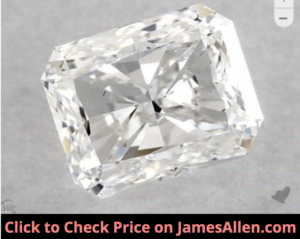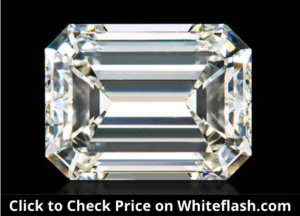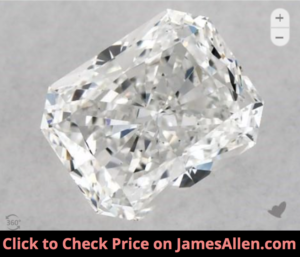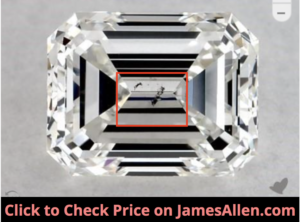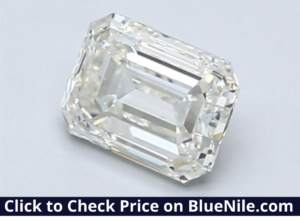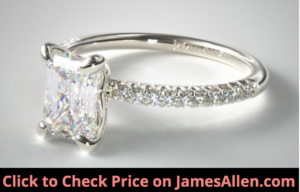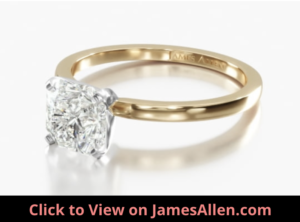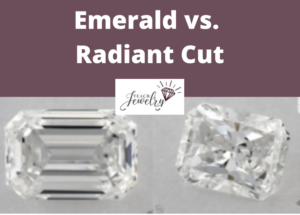
Emerald and radiant cut diamonds are two fancy shapes used in engagement rings and other jewelry.
Both have a unique style that distinguishes it from a traditional round cut.
The main difference between emerald and radiant cut diamonds is emerald cuts have step-cut facets that reduce their brilliance. The brilliant cut facets on a radiant cut allow it to capture and reflect more light, so it has more sparkle compared to an emerald cut. Both often have a rectangular overall shape.
Let’s explore details of emerald versus radiant cuts across the areas most important to your decision, from its clarity and color to price and popularity.
What is an Emerald Cut Diamond?
The distinct features of an emerald cut diamond are its step-cut facets and elongated, rectangular shape. Linear facets run parallel down the table, creating a wider surface area than what’s found in most other cuts.
Many have 57 facets. They’re described as a set of steps that start in the middle and extend outward, creating a “hall of mirrors” effect.
Check out the high-resolution image of this exceptional one-carat emerald cut diamond.
Notice how the facets move toward the outside.
Emerald cuts have four beveled corners and polished edges, creating a total of eight sides. Four have the same length, and the other four are also identical to each other.
The traditional length-to-width ratio is 1.3-1.5, and 1.4 is optimal. It won’t be mistaken for a square diamond if it’s within that ratio.
Here are two examples of emerald cuts with different ratios.
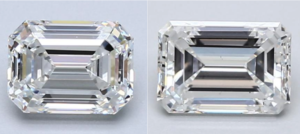
The one on the left appears more like a square than the one on the right, though both are rectangles.
One reason buyers choose emerald cuts for their engagement ring is they cost less per carat than most brilliant cuts.
You can choose a larger diamond for the same price or put that savings toward qualities like its clarity grade or a setting.
What is a Radiant Cut Diamond?
Radiant cuts have 70 brilliant cut facets designed to enhance light return.
Its facets are the same style as the ones in a round cut, but they’re cut into many different sizes and angles, which gives the appearance of crushed ice.
One of the pros of radiant cuts is they’re available in a wide range of length-to-width ratios. Square-shaped radiant cuts are often between 1.00-1.03. Rectangular ones often measure between 1.20-1.30.
It rose to popularity in the 1970s when Henry Grossbard developed the first cut with a square shape and brilliant facets on the crown and pavilion.
He combined traits of emerald and round diamonds to create what is known as a radiant cut.
You can identify the similarities in this radiant cut.
Rotate the image to compare its appearance at every angle.
What are Differences Between Emerald and Radiant Cuts?
1. Light Performance
A diamond’s light performance refers to the combination of brilliance and fire, which together create scintillation.
Brilliance is the white light that radiates when it’s twirled. Fire is the colored flashes.
Emerald cuts lack light performance compared to radiant cuts. The elongated, step-cut facets aren’t designed to collect and return the maximum amount of light.
Check out the emerald cut below, and notice its lengthy, step-cut facets.
They produce a subtle sparkle, more comparable to a warm glow.
Radiant cuts, on the other hand, have strong fire and brilliance because of its triangular- and kite-shaped facets.
Although the overall shape of the diamond is distinct from a round cut, the facets themselves imitate that style.
They minimize light leakage and instead return more to the viewer.
If you’re searching for a diamond that glimmers, choose radiant over emerald with a length to width ratio closer to a square than a rectangle.
2. Clarity
Inclusions that develop inside a diamond during its formation affect its durability, appearance, and light performance. The presence of these flaws make up its clarity grade, which ranges from flawless to I3.

Some cuts hide inclusions to the naked eye more effectively than others.
In the comparison of emerald versus radiant cuts, radiant cuts are superior at hiding inclusions.
Their brilliant cut facets reflect more white light, which disguises some small inclusions like clouds, twinning wisps, or feathers.
Emerald cuts have large facets that leave inclusions more exposed.
That means you can choose a radiant cut with a lower clarity grade than an emerald cut, and the two could look similar in regard to inclusions.
For example, this one-carat radiant cut diamond earned an SI1 clarity grade from the Gemological Institute of America.
Even when viewed through high-resolution images, the inclusions are barely visible, indicating this diamond is likely eye-clean.
This one-carat emerald cut also earned an SI1 clarity grade, but its inclusions are noticeable.
There are multiple black specks scattered across the table, which are likely visible when viewed without magnification.
Radiant cut diamonds that weigh close to one-carat are often eye-clean with an SI1 clarity grade, but I recommend starting your search at VS2 for emerald cuts.
3. Color
A diamond’s color grade, on a scale of D to Z, refers to the presence of yellow or brown tints.
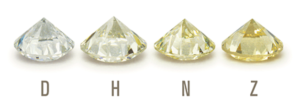
Similar to clarity, some cuts show color more than others. The primary factors are the size of its facets and the way they’re cut, so emerald cuts show more color than radiant diamonds.
Their large, step-cut facets retain yellow more than the small, triangular facets on radiant cuts.
In emerald cuts that weigh close to one carat, you’ll often start to notice yellow tints if its color grade is I or below.
So I recommend starting your search with a H color grade.
This emerald cut earned a J color grade from the GIA.
Notice the slight yellow shade, especially toward its edges.
Radiant cuts often hide yellow tints if they’re at least an J color grade, but I color are the safer bet.
For example, this one-carat diamond earned an I grade.
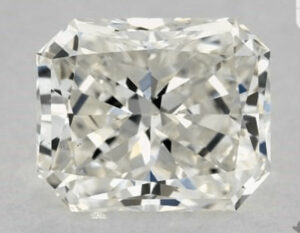
Even with high-quality images, it appears colorless.
This reduces the cost of the diamond because you can choose a lower color grade and have it look identical to an emerald cut with a higher grade in respect to color.
4. Durability
Consider the durability of your diamond cut because chips and cracks are difficult to hide and could cause it to fall out of the setting.
There are many factors that determine durability, including:
- Girdle thickness
- Proportions
- Size and location of inclusions
Another vulnerable area is pointed corners, like those on baguette, princess, or marquise cut diamonds.
Emerald and radiant cuts are equally durable because their edges have similar cuts. Instead of pointed corners, their edges are beveled to form four smaller sides.
On the other hand, they’re more vulnerable than cuts like round or oval, which only have rounded ends.
5. Price
The price of a diamond is determined by its cut and the grade it receives across the four Cs of color, cut, clarity, and carat. As it moves higher on those scales, cost generally rises.
Radiant cuts are more expensive than emerald cuts because of their brilliant cut facets. Its strong light performance is a coveted trait for engagement ring diamonds.
Another factor that impacts diamond price is how much of the original rough diamond is wasted to form its shape. For radiant and emerald cuts, waste is minimal.
To compare prices for emerald versus radiant cuts, I assessed costs for those cuts from James Allen that earned the following grades:
- Carat weight: 1.00
- Cut: VS2
- Color: G
The average price for an emerald cut with those qualities was $4,850, with a range of $3,560-$5,730.
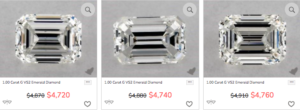
For a radiant cut, the average price was $5,098. The range was $3,840-$7,080.
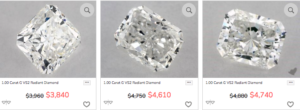
This demonstrates you can expect to pay about five percent more for a radiant cut compared to an emerald cut, but there are plenty of exceptions to the rule.
Online jewelry retailer Blue Nile compiled prices for different cuts with the same grades and found their radiant cuts are often 16 percent more expensive than emerald cuts.
6. Popularity as Engagement Rings
Although radiant cuts are more brilliant, which is often an important criteria for engagement rings, emerald cuts are generally more popular.
About three percent of engagement rings have an emerald cut at the center.
When combined with a pavé, such as the example below, it creates a stunning piece because of the way round brilliants on the shank complement the emerald cut.
Radiant cuts make up about two percent of sales.
Buyers interested in a brilliant cut often choose round, princess, marquise, cushion, or oval cut diamonds.
These are all more popular than radiants. In fact, radiant cuts often rank as one of the least popular brilliant cut for engagement rings.
Emerald cuts are the fifth most popular cut for diamond rings but the most common step cut. Other step-cuts like baguette, Asscher, and carre diamonds are rarely used as the center diamond.
Whether you choose an emerald or radiant cut, you’ll have an engagement ring that offers an alternative to the classic brilliant cuts.
7. Settings
The right setting for a radiant or emerald cut completes the piece. Both fit a variety of settings, but there are some styles that best pair with their shape.
For radiant cuts, consider four prong settings, where each prong latches onto one of its short edges. Its distinct overall shape remains visible, and more of the table is exposed to showcase its brilliance.
For example, this one-carat radiant cut diamond ring has a four-prong setting in 18K yellow gold.
Flat prongs grip each corner, leaving the table open to capture and reflect light.
Bezel settings wrap around a radiant cut.
While it’s better protected against hits and drops, the setting covers the diamond’s outer edges.
Emerald cuts have minimal brilliance, but one way to improve its performance in this area is for the setting to include brilliant cut diamonds.
If you don’t wait to avoid round cut diamonds altogether, you can have two placed on either side of the emerald cut, like in this petite micropave trio diamond ring.
How to Decide Between an Emerald and Radiant Cut
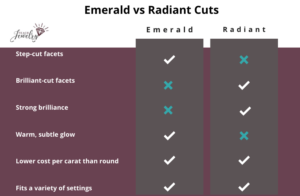
Comparing emerald versus radiant cut diamonds involves understanding the distinct features of each cut and how they affect the overall performance of the piece.
Here are some guidelines to help you decide.
Choose an emerald cut if:
- Its lack of brilliance isn’t a problem for you
- You’re looking for a diamond with a lower cost-per-carat than most brilliant cuts
- You want a diamond that looks larger to the naked eye than many other cuts
Opt for a radiant cut if:
- You want a brilliant cut diamond that’s less expensive than a round cut
- Its square or rectangular shape is appealing, but you still want brilliant cut facets
By pairing radiant and emerald cuts with different styles of settings, you’ll find the perfect diamond ring for you.

Jacob Clarke
Jacob Clarke is the founder of TeachJewelry.com.
He earned an Applied Jewelry Professional Diploma from the Gemological Institute of America (GIA) and now brings you essential information about diamonds, settings, and more.
Jacob has consulted with leading jewelry brands, and his work has been cited in Clean Origin, Diamond Nexus and industry publications.
He's also a member of the International Gem Society.
He enjoys discussing jewelry with readers, so contact him with any questions at jacob.clarke@teachjewelry.com.

